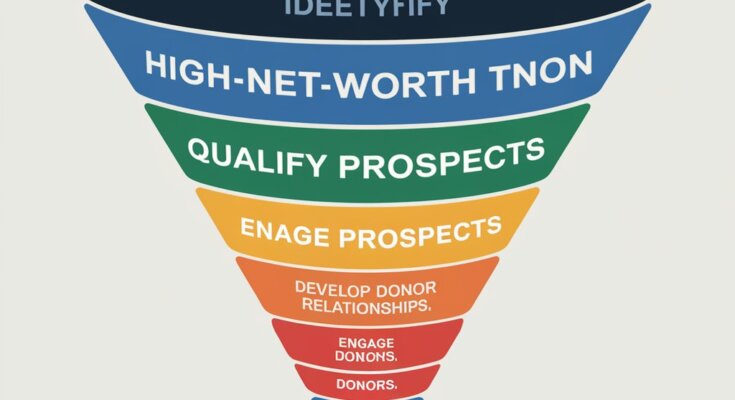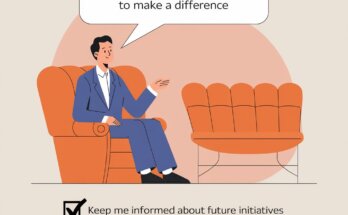In the nonprofit world, establishing a prospect pipeline for high-net-worth donors (HNWDs) is crucial for securing significant funding and ensuring the sustainability of your organization.
This guide will walk you through the process of creating a solid pipeline to attract and engage HNWDs, ensuring your fundraising efforts yield the best results.
We’ll break down each step in a way that is easy to understand and apply, providing practical examples to illustrate how these strategies can work for your nonprofit.
Understanding the Importance of a Prospect Pipeline
A prospect pipeline refers to a structured approach to identifying, nurturing, and soliciting potential donors. It’s not merely about asking for money; it’s about building genuine relationships and understanding what drives HNWDs to give. These individuals often have specific interests and motivations, making it vital to cultivate a strong connection with them.
Why Focus on High-Net-Worth Donors?
High-net-worth donors can dramatically impact your nonprofit’s funding goals. They have the resources to contribute larger amounts, often leading to significant projects or operational support.
By focusing on HNWDs, you’re not just looking for one-time donations; you’re fostering long-term partnerships that can lead to sustainable support.
Step 1: Define Your Ideal Donor Profile
The first step in building your prospect pipeline is to create a clear picture of your ideal donor. Who are they? What causes do they care about?
Understanding these aspects will help you identify prospects who are likely to connect with your mission.
Practical Example: Create a Donor Persona
Imagine you run a nonprofit focused on education for underprivileged youth. Your ideal donor might be someone who has a background in education, a history of supporting youth programs, or personal ties to the community you serve. To create your donor persona, consider factors such as:
- Demographics: Age, gender, occupation, and location.
- Philanthropic Interests: Areas they care about, such as education, health, or the environment.
- Giving History: Previous donations or involvement with similar organizations.
Step 2: Conduct Thorough Research
Once you’ve defined your ideal donor, it’s time to conduct thorough research to identify potential prospects. Utilize various tools and platforms to gather data about individuals who fit your donor persona.
Data and Research Tools
- Wealth Screening Tools: Services like WealthEngine and DonorSearch provide valuable insights into potential donors’ financial capacity and giving history.
- Social Media: Platforms like LinkedIn can help you identify connections and engage with HNWDs in your network.
- Public Records: Review local news articles and community bulletins for mentions of philanthropic activities or individuals who have made significant contributions in your area.
The Power of Research
Consider the story of a nonprofit focused on homelessness prevention. After conducting thorough research, they identified a successful tech entrepreneur who had previously supported initiatives related to affordable housing.
By understanding this donor’s passion, they were able to tailor their outreach and eventually secured a significant donation that helped fund a new housing project.
Step 3: Cultivate Meaningful Relationships
Building relationships with HNWDs takes time and effort. Here are some effective strategies to cultivate those connections:
a. Personalize Your Outreach
When reaching out to potential donors, personalization is key. Avoid generic messages that lack sincerity. Instead, reference their interests or past engagements.
Example: If a prospect attended a charity gala focused on education, mention this in your initial email and share relevant insights or successes from your organization.
b. Host Exclusive Events
Create opportunities for prospects to engage with your organization by hosting exclusive events. These gatherings can be intimate dinners, behind-the-scenes tours, or special lectures related to your mission.
Example: If your nonprofit focuses on animal welfare, consider hosting a private event at an animal shelter where prospects can interact with rescue animals and learn more about your work.
c. Consistent Communication
Keep your prospects informed and engaged with regular updates about your organization. Use newsletters, social media, and personalized emails to share news, success stories, and challenges you’re facing.
Step 4: Qualify Your Prospects
Not every prospect will be the right fit for your organization. Qualifying your prospects allows you to prioritize those who are most likely to engage and contribute.
How to Qualify Prospects
- Capacity to Give: Assess their financial background and past giving patterns.
- Interest Alignment: Ensure their philanthropic interests align with your mission.
- Engagement Level: Track their interactions with your organization, such as event attendance or volunteer work.
Practical Example: Scoring System
Create a scoring system based on key criteria. Assign points for each positive attribute, allowing you to rank your prospects and focus your outreach efforts on the most promising individuals.
Step 5: Develop a Stewardship Plan
Once you’ve established relationships with HNWDs, it’s crucial to implement a stewardship plan. This plan outlines how you’ll maintain and nurture your connections over time.
a. Acknowledge Their Support
Always express gratitude to your prospects for their time, interest, and any contributions they may have made. A personalized thank-you note or follow-up call can go a long way in building rapport.
b. Provide Regular Updates
Keep your prospects informed about your organization’s progress and successes. Share impact stories and data to demonstrate the difference their support can make.
c. Encourage Involvement
Invite prospects to participate in your organization’s activities beyond financial support. Whether it’s joining a committee, volunteering, or attending events, deeper involvement fosters stronger connections.
Step 6: Create an Effective Solicitation Strategy
When it’s time to ask for support, having a well-thought-out solicitation strategy is crucial. Here are key elements to consider:
a. Timing is Everything
Don’t rush into asking for funds. Ensure that the relationship has matured and that the prospect feels a genuine connection to your organization.
b. Tailored Proposals
When making a solicitation, tailor your proposal to align with the donor’s interests and values. Use specific examples of how their contribution will make an impact.
c. Face-to-Face Meetings
Whenever possible, request face-to-face meetings. Personal interactions can build trust and rapport, making it easier to discuss financial support.
The Art of the Ask
Let’s consider a small nonprofit focused on community health initiatives. After months of relationship building with a local business leader passionate about public health, they arranged a meeting.
During the meeting, the nonprofit director shared a compelling story about a community member whose life had changed thanks to their programs.
By focusing on personal impact rather than numbers, they successfully secured a substantial donation that allowed them to expand their outreach.
Step 7: Evaluate and Adjust Your Approach
Building a prospect pipeline is an ongoing process. Regularly evaluate your strategies to determine what works and what doesn’t. Be willing to adjust your approach based on results.
Data Analysis
Use donor management software to track interactions, contributions, and engagement levels. Analyzing this data will help you identify successful outreach methods and areas that need improvement.
Take Action for Your Nonprofit’s Future
Creating a prospect pipeline for high-net-worth donors is an essential strategy for nonprofits seeking to maximize their fundraising potential.
By defining your ideal donor, conducting thorough research, cultivating meaningful relationships, qualifying your prospects, developing a stewardship plan, and implementing a targeted solicitation strategy, you’ll be well on your way to engaging HNWDs who are passionate about your mission.
Call to Action: For more expert tips, resources, and access to exclusive opportunities such as job postings, grant opportunities, and webinars, subscribe to the Nonprofit Navigators Newsletter.
Join our community and elevate your nonprofit’s fundraising efforts today!
Additional Resources:
- The Small Business’s Guide to Winning Grants
- Request for Proposal Success: How to Write Proposals That Win
- The Ultimate Guide to Federal Grant Applications: Techniques for Success
- Digital Marketing for Nonprofits: A Comprehensive Guide to Boosting Your Impact Online
- Mastering Online Fundraising: A Nonprofit’s Guide to Digital Success




